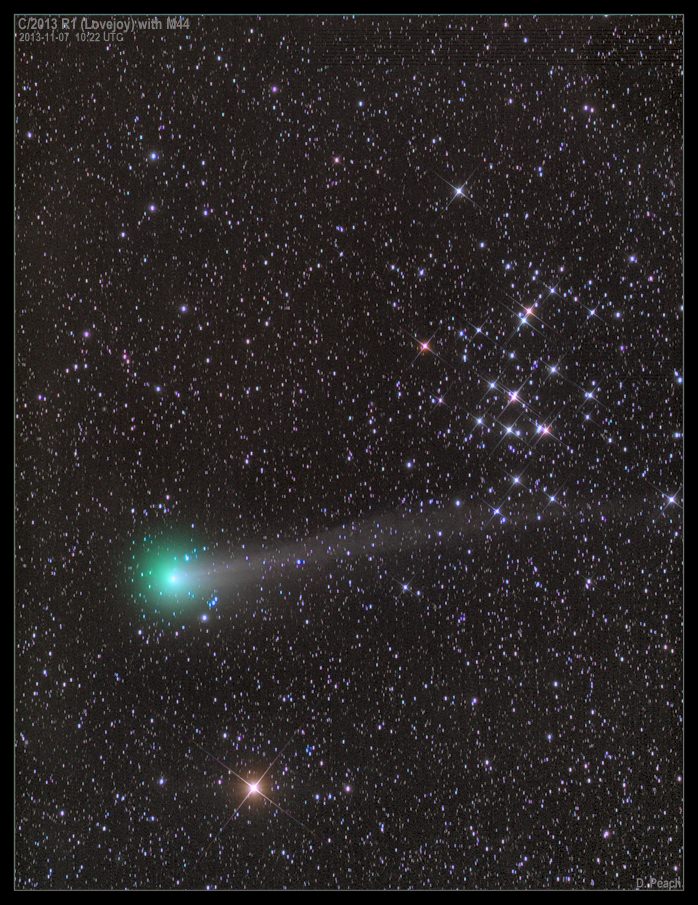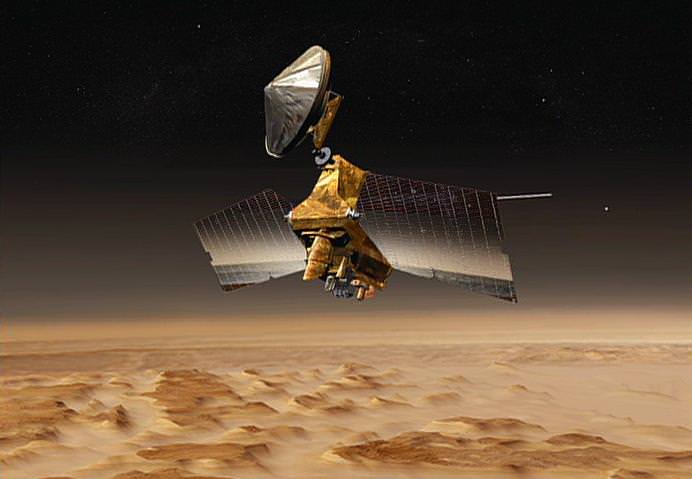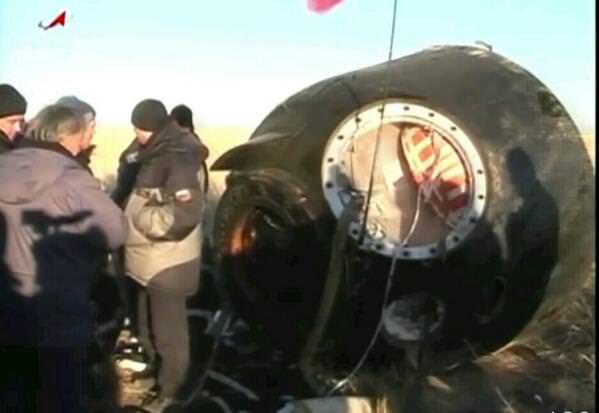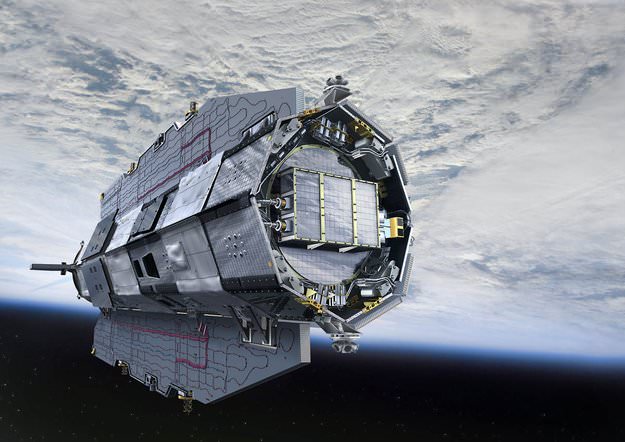Sometimes the Sun is quiet, and other times the Sun gets downright unruly. During the peak of its 11-year cycle, the surface of the Sun is littered with darker sunspots. And its from these sunspots that the Sun generates massive solar flares, which can spew radiation and material in our direction. What causes these flares, and how worried should we be about them in our modern age of fragile technology?
Continue reading “Astronomy Cast 321: Solar Flares”
India’s Mars Orbiter Mission (MOM) Requires Extra Thruster Firing after Premature Engine Shutdown
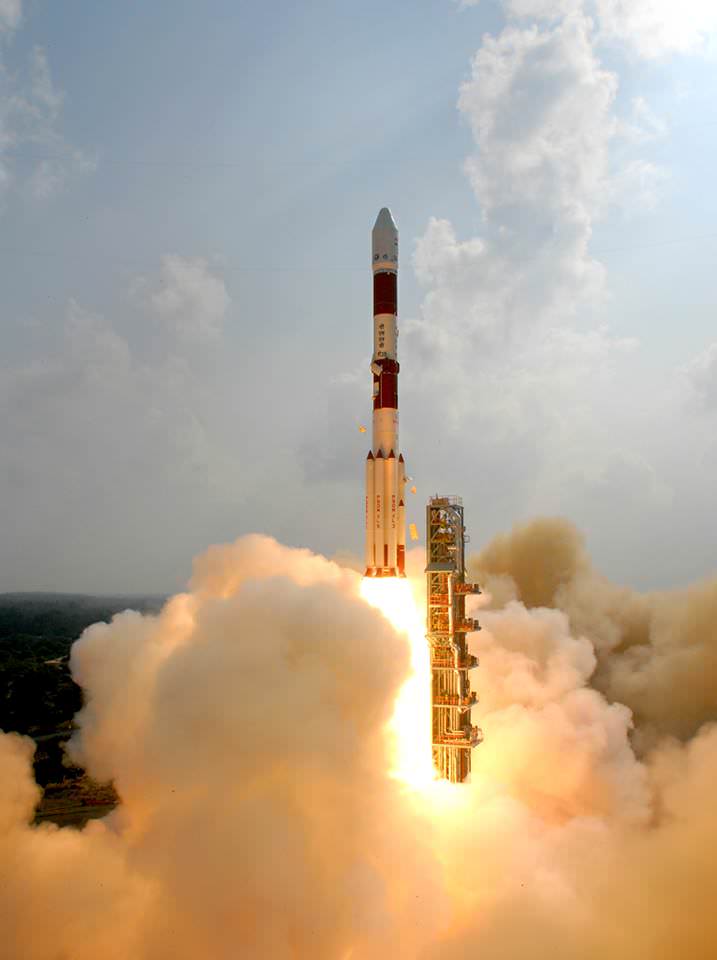
India’s Mars Orbiter Mission (MOM) probe suffered a surprise hiccup overnight (Nov. 11 IST) when the main engine shut down prematurely and left the country’s first ever mission to the Red Planet flying in a significantly lower than planned interim elliptical orbit around Earth – following what was to be her 4th orbit raising burn since last week’s flawless launch.
“MOM is in normal health,” at this time according to the Indian Space Research Organization (ISRO) – which has now scheduled a supplementary main engine firing for early Tuesday (Nov. 12) to boost the crafts orbit the missing 20,000 km required.
Monday’s engine firing only raised MOM’s apogee (farthest point to Earth) from 71,623 km to 78,276 km compared to the originally planned apogee of about 100,000 [1 lakh] km), said ISRO in a press release.
This is the first serious problem to strike MOM in space. And it seemed clear to me something might be amiss when ISRO failed to quickly announce a successful completion of the 4th firing as had been the pattern for the initial three burns.
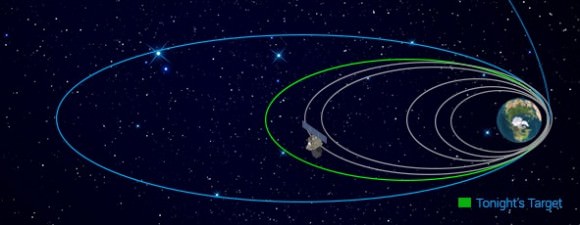
The premature shutdown of the liquid fueled 440 Newton main engine “imparted an incremental velocity of 35 metres/second as against 130 metres/second originally planned,” ISRO stated.
That’s barely a quarter of what was hoped for.
“A supplementary orbit-raising operation is planned tomorrow (November 12, 2013) at 0500 hrs IST to raise the apogee to nearly 1 lakh [100,000] km.”
A series of six absolutely essential firings of the 440 Newton main engine – dubbed “midnight maneuvers” – had been originally scheduled by Indian space engineers.
The purpose of the “midnight maneuvers” is to achieve Earth escape velocity by gradually raising MOM’s apogee over several weeks, and set her on a trans Mars trajectory to the Red Planet, following the spectacular blastoff on Nov. 5 from India’s spaceport.
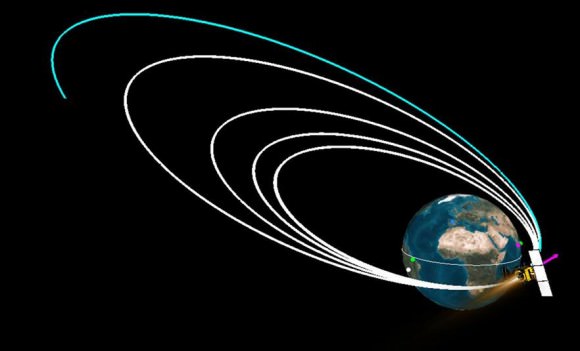
MOM was due to depart Earth’s orbit on Dec. 1 after accomplishing the 6th of the originally scheduled thruster firings – and begin a 10 month long interplanetary cruise to Mars.
MOM’s picture perfect Nov. 5 liftoff atop India’s highly reliable four stage Polar Satellite Launch Vehicle (PSLV) C25 from the ISRO’s Satish Dhawan Space Centre SHAR, Sriharikota, precisely injected the spacecraft into an initial elliptical Earth parking orbit of 247 x 23556 kilometers with an inclination of 19.2 degrees.
The 1st, 2nd and 3rd thruster firings were spot on and incrementally raised MOM’s apogee from 23556 km to 28814 km, 40186 km and 71,623 km respectively.
The next firing had been slated for Nov. 16.
Here’s how ISRO described the source of the main engine shutdown:
“During the fourth orbit-raising operations held today (November 11, 2013), the redundancies built-in for the propulsion system were exercised, namely, (a) energising the primary and redundant coils of the solenoid flow control valve of 440 Newton Liquid Engine and (b) logic for thrust augmentation by the attitude control thrusters, when needed.
However, when both primary and redundant coils were energised together, as one of the planned modes, the flow to the Liquid Engine stopped. The thrust level augmentation logic, as expected, came in and the operation continued using the attitude control thrusters. This sequence resulted in reduction of the incremental velocity.”
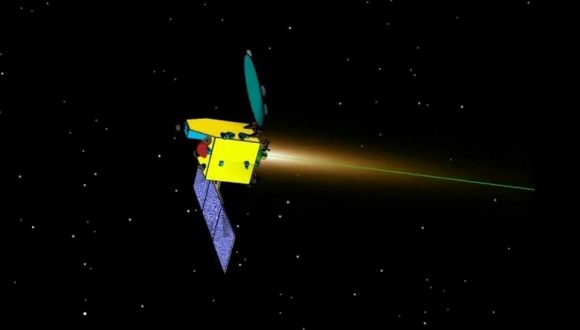
It is not known at this time how or whether the requirement for a supplemental “midnight maneuver” engine firing will affect the mission’s timing at Earth and its operations and longevity at Mars.
Why are the firings called midnight maneuvers?
“Firing has to happen near the perigee and in the visibility from ISTRAC ground stations. All these orbits have argument of perigee of ~285 deg. When all these constraints are put together, firings time will almost always fall in to midnights of Indian sub continent,” said ISRO in response to a readers inquiry.
In the latest update, ISRO reports: “After achieving an apogee of around 78,000 km in last night’s Maneuver, ISRO’s Mars Orbiter Mission Spacecraft is all set to reach the apogee of One lakh km in a supplementary maneuver scheduled for 5 AM tomorrow. [Nov 12].”
MOM was to arrive in the vicinity of Mars on September 24, 2014 when the absolutely essential Mars orbital insertion firing by the 440 Newton liquid fueled main engine will slow the probe and place it into a 366 km x 80,000 km elliptical orbit.
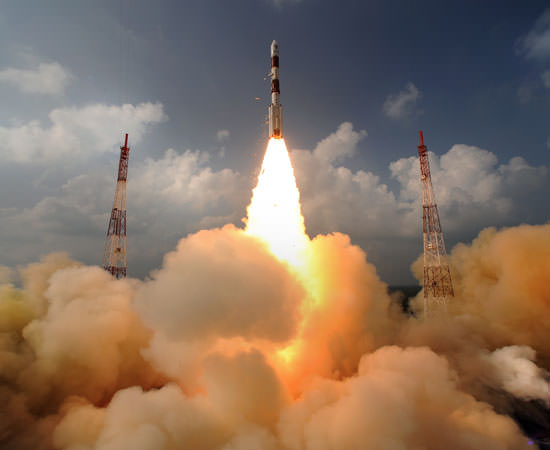
If all goes well, India will join an elite club of only four who have launched probes that successfully investigated the Red Planet from orbit or the surface – following the Soviet Union, the United States and the European Space Agency (ESA).
The low cost $69 Million MOM mission is the first of two new Mars orbiter science probes from Earth blasting off for the Red Planet this November.
Half a world away, NASA’s $671 Million MAVEN orbiter remains on target to launch in less than one week on Nov. 18 – from Cape Canaveral, Florida.
Both MAVEN and MOM’s goal is to study the Martian atmosphere, unlock the mysteries of its current atmosphere and determine how, why and when the atmosphere and liquid water was lost – and how this transformed Mars climate into its cold, desiccated state of today.
The MAVEN and MOM science teams will “work together” to unlock the secrets of Mars atmosphere and climate history, MAVEN’s top scientist Prof. Bruce Jakosky told Universe Today.
Stay tuned here for continuing MOM and MAVEN news and Ken’s MAVEN launch reports from on site at the Kennedy Space Center press center
…………….
Learn more about MAVEN, MOM, Mars rovers, Orion and more at Ken’s upcoming presentations
Nov 14-19: “MAVEN Mars Launch and Curiosity Explores Mars, Orion and NASA’s Future”, Kennedy Space Center Quality Inn, Titusville, FL, 8 PM
Dec 11: “Curiosity, MAVEN and the Search for Life on Mars”, “LADEE & Antares ISS Launches from Virginia”, Rittenhouse Astronomical Society, Franklin Institute, Phila, PA, 8 PM
Tracking Comet C/2013 R1 Lovejoy through November
Tired of comets yet? Right now, northern hemisphere observers have four (!) comets within range of binoculars in the dawn sky. Comet C/2012 S1 ISON, is, of course, expected to dazzle towards month’s end. Comet 2P/Encke is an “old standby,” with the shortest orbital period of any comet known at 3.3 years, and is making a favorable appearance this Fall. And comet C/2012 X1 LINEAR added to the morning display recently, reaching about +8th magnitude in an unexpected outburst…
But the brightest and best placed comet for morning viewing is currently Comet C/2013 R1 Lovejoy. Shining at +6th magnitude, R1 Lovejoy just passed into the constellation Leo after a photogenic pass near the Beehive Cluster (M44) in Cancer last week. We caught sight of R1 Lovejoy a few mornings ago, and it’s an easy binocular object, looking like a fuzzy unresolved globular cluster with barely the hint of a tail.
If the name sounds familiar, that’s because the comet was discovered by Australian observer Terry Lovejoy, the prolific discoverer of four comets, including the brilliant sungrazing Comet C/2011 W3 Lovejoy that survived its 140,000 kilometre perihelion passage above the surface of the Sun on December 16th and went on to dazzle southern hemisphere observers in late 2011 and early 2012.
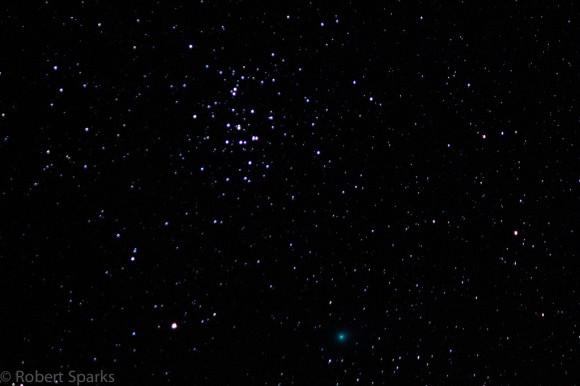
Terry discovered R1 Lovejoy on September 7th, 2013 while it was still at magnitude +14.4. The comet is expected to top out at +4th magnitude in late November as it passes 61.4 million kilometres from Earth on November 19th and heads for perihelion at 0.877 AUs from the Sun on December 25nd, 2013. Comet R1 Lovejoy is on a 64 degree orbit highly inclined to the ecliptic, and has a period roughly 7,000 years long. The last time R1 Lovejoy graced Earthly skies, our early ancestors still thought copper smelting was a pretty hip idea!
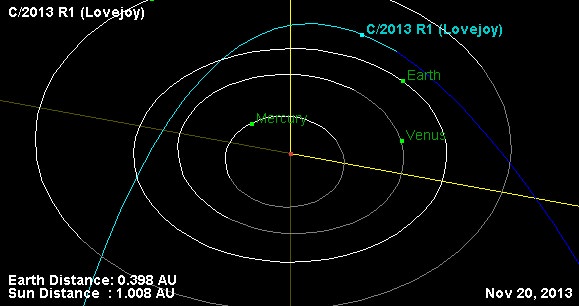
And unlike comets Encke and ISON that are plunging near the Sun, Comet R1 Lovejoy never gets closer than 19 degrees elongation from our nearest star in late December. It also reaches a maximum northern declination of 43 degrees on November 28th, the same day that ISON reaches perihelion. For mid-latitude northern hemisphere observers, R1 Lovejoy will remain well placed at 35 to 45 degrees above the northeastern horizon about an hour before sunrise through late November.
Here are some key dates to aid you in your quest to spy Comet R1 Lovejoy in late November:
November 11th: Passes near +4.5 Kappa Leonis.
November 14th: Passes from Leo into the constellation Leo Minor & passes near the +5.3 star 20 Leonis Minoris.
November 16th: Passes near the +5th magnitude stars 28, 30, and 34 Leonis Minoris.
November 18th: Passes into the constellation Ursa Major.
November 19th: Passes near the +4.8 magnitude star 55 Ursae Majoris & +5.3 magnitude star 57 Ursae Majoris.
November 19th: Closest to Earth, at 0.4 AUs distant.
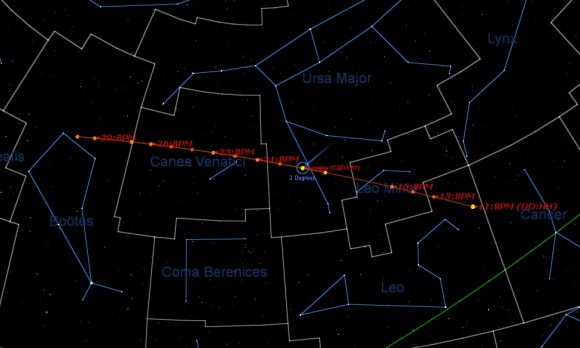
November 21st: Passes into the constellation Canes Venatici.
November 22nd: Passes near the +6th magnitude star 4 Canum Venaticorum & the +4.2 magnitude star Chara (Beta Canum Venaticorum).
November 24th: Passes near the Sunflower Galaxy (M63).
November 27th: Passes into the constellation Boötes.
December 1st: Passes near +3.5 magnitude star Nekkar (Beta Boötis).
December 4th: crosses into Corona Borealis.
Note that passes on the list above denote passages closer than one degree of Comet R1 Lovejoy near bright objects.
Perihelion for the comet is December 25th at 0.877 AU, and its closest approach to Earth is November 19th. On this date, it will also be moving at its maximum apparent speed as seen from Earth, covering about 3 degrees of the sky every 24 hours, or the angular span of the Full Moon every 4 hours.
United Kingdom observer Pete Lawrence imaged Comet R1 Lovejoy this past weekend from his backyard garden using a 4-inch apochromatic refractor and a Canon 40D DSLR:
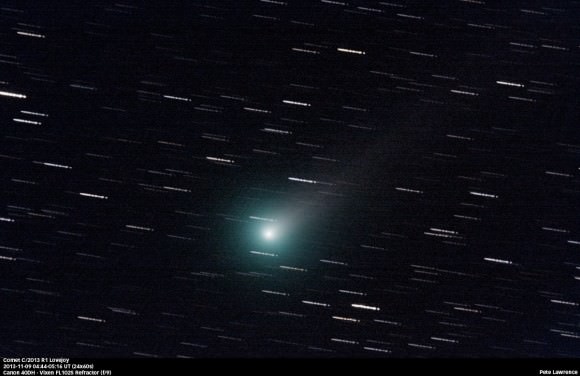
He also made his first confirmed binocular sighting of Comet ISON using a pair of 15×70 binocs, noting to Universe Today that “ISON’s head appears to be small and stellar compared to Lovejoy’s extended coma, which is obvious in binoculars, and also brighter!”
It’s worth noting that all four of these morning comets are on separate orbital paths, and only seem to be in the same general region of the sky as seen from our Earthly vantage point… and none of them are passing near the Earth!
This week is also a good time to hunt for comets in the pre-dawn sky for another reason: the Moon reaches Full this coming weekend on Sunday, November 17th. After this week, it will start to creep into the morning sky and interfere with deep sky observations for the next two weeks.
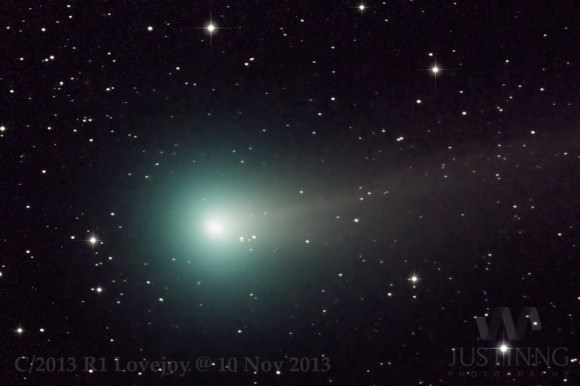
It’s also interesting to note that amateur observers discovered two more faint comets this past weekend. Though comets C/2013 V3 Nevski and C/2013 V2 Borisov aren’t slated to be anything spectacular, that brings the number of amateur discoveries to 13 for 2013. Are amateur comet hunters mounting a comeback?
In this age of automated surveys, the question is often raised as to whether amateurs can still discover comets. Keep in mind, Terry Lovejoy found Comet R1 Lovejoy with a medium-sized 8-inch Schmidt Cassegrain reflecting telescope… the age of amateur comet hunters seemes far from over in 2013!
Carnival of Space #327
The tent is up! This week’s Carnival of Space is hosted by Pamela Hoffman at the Everyday Spacer blog.
Click here to read Carnival of Space #327.
And if you’re interested in looking back, here’s an archive to all the past Carnivals of Space. If you’ve got a space-related blog, you should really join the carnival. Just email an entry to [email protected], and the next host will link to it. It will help get awareness out there about your writing, help you meet others in the space community – and community is what blogging is all about. And if you really want to help out, sign up to be a host. Send an email to the above address.
How Much Science Data Has The Mars Reconnaissance Orbiter Sent To Earth?
Imagine being able to watch three months’ worth of high-definition space video sequentially — maybe real-time coverage on the International Space Station, or getting to watch the Mars Reconnaissance Orbiter zoom across the Red Planet over and over again. Well, that’s how much science data MRO itself has sent back in 10 years of operations, NASA said.
“The sheer volume is impressive, but of course what’s most important is what we are learning about our neighboring planet,” stated the Jet Propulsion Laboratory’s Rich Zurek, the project scientist for the Mars Reconnaissance Orbiter.
MRO has sent back 200 terabits, all told. It’s a wealth of science data on its own merits as it examined evidence of water, ancient volcanoes and other parts of the Red Planet’s history from above. The spacecraft, however, also serves as a relay for the NASA Curiosity and Opportunity rovers on the surface.
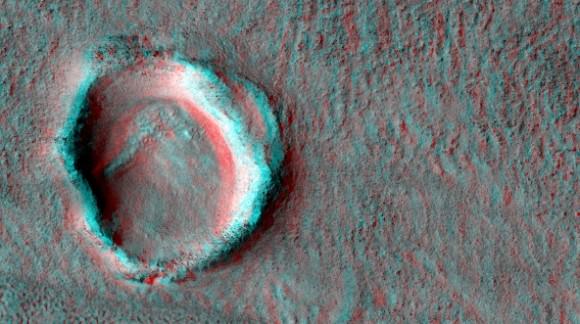
“Data gathered by the orbiter’s instruments and relayed from rovers are recorded onto the orbiter’s central memory. Each orbit around Mars takes the spacecraft about two hours. For part of each orbit, Mars itself usually blocks the communication path to Earth,” NASA stated.
“When Earth is in view, a Deep Space Network antenna on whichever part of Earth is turned toward Mars at that hour can be listening. Complex preparations coordinate scheduling the use of the network’s antennas by all deep-space missions — 32 of them this month. Mars Reconnaissance Orbiter typically gets several sessions every day.”
Once the Deep Space Network antennas in Spain, California and Australia pick up the data, JPL organizes them into their separate “products”, ranging from radar measurements from above to data picked up by a rover below. The information is then sent to various organizations around the world that have interests in the work.
MRO arrived at Mars in 2006 and its mission has been extended three times, with the latest one taking place in 2012. NASA also relays information from the planet using Mars Odyssey, which has been there since 2002.
Source: NASA
Soyuz Spacecraft Landing: ‘The Ultimate Roller-Coaster Ride Back To Earth’
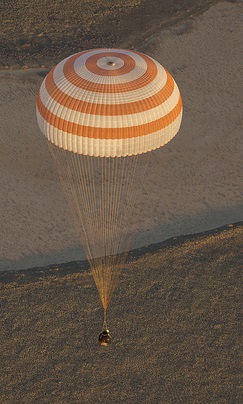
“It’s only in the moment that you’re in your spacesuit, and that the hatches are closing, that you know that four hours later, you will be back on Earth.”
That’s European Space Agency astronaut Frank De Winne talking about the emotions an astronaut or cosmonaut feels as they leave the International Space Station in a Soyuz spacecraft. The new ESA video, posted above, shows just how hard the astronauts and ground teams have to work to make sure the spacecraft gets to the right spot.
From training, to calculating orbital trajectories, to making sure the landing site in Kazakhstan is free of debris, it’s easy to see how easily those landing teams get up to dozens and dozens of people.
The undocking itself can be complex; depending on which port the Soyuz is attached to, the International Space Station itself may have to change its position to make sure the spacecraft is in the right orientation to head back to Earth.
After navigating the hazards of space, sometimes the landing site can be treacherous as well. In Kazakhstan, the mounds of snow can build up in the area in the winter time; crews need to be prepared to retrieve the spacefarers in just about any weather condition.
Luckily for the returning Expedition 36/37 crew yesterday, conditions were clear — albeit pretty cold, at 26 degrees Fahrenheit (-3 degrees Celsius). Check out Universe Today‘s full coverage of the successful crew and Olympic torch landing here.
How Astronomy Benefits Society and Humankind
With an annual cost of $30.8 million, the Keck Observatory costs $53.7 thousand for a single night’s worth of operation. It will cost the James Webb Space Telescope approximately $8.8 billion to reach orbit. And the Space Launch System that will carry the Orion capsule is expected to cost $38 billion.
Why should we be spending such a vast amount of money on astronomy? How is it useful and beneficial to society?
Astronomers face this question on a daily basis. Recently a ream of European astronomers have provided tangible answers relating advancements in astronomy to advancements in industry, aerospace, energy, medicine, international collaboration, everyday life and humankind.
“I get this question quite often,” Dr. Marissa Rosenberg, lead author on the paper, told Universe Today. “One very personal reason for writing this article is that I wanted to share with my parents (both business people) why what I am doing is important and a necessary facet of society.”
Today, millions of people across the world are affected by advances in astronomy.
Industry
— Your iPhone’s camera is a charge-coupled device (CCD) — an instrument, which converts the movement of electrical charge into a digital value. Originally developed for astronomy, CCD’s are now used in most cameras, webcams and cell phones.

— The computer language Forth, originally developed for the 36-foot telescope on Kitt Peak is now used by FedEx to track packages.
— AT&T uses IRAF — software written by the National Optical Astronomy Observatory — to analyze computer systems.
— Kodak film, originally created by astronomers studying the sun, is used extensively by the medical and industrial industries, photographers and artists.
Aerospace
— Space-based telescopes have advanced defense satellites, which require identical technology and hardware.
— Global Positioning System satellites rely on astronomical objects — quasars and distant galaxies — to determine accurate positions.
Energy
— Technology gained from imaging X-rays is now used to monitor fusion — where two atomic nuclei combine to form a heavier nucleus — that may prove to be our answer for clean energy.
Medicine

Astronomy struggles to see increasingly faint objects; Medicine struggles to see things obscured within the human body.
— Aperture synthesis — the process of combining data from multiple telescopes to produce a single image seemingly created from a telescope the size of the entire collection — first developed by a radio astronomer has been used for multiple medical imaging tools, including CAT scanners and MRIs.
— Building space-based telescopes requires an extremely clean environment in order to avoid dust particles from obscuring the mirrors or instruments. Similar methods and instruments are now used in hospitals and pharmaceutical labs.
International Collaboration
— Collaboration also inspires competition. The Space Race — a competition between the Soviet Union and the United States for supremacy in space exploration — landed Neil Armstrong, Michael Collins and Buzz Aldrin on the moon.
— Astronomy is a collaborative effort. In 1887 astronomers from around the world pooled their telescope images in order to create the first map of the entire sky. Today, astronomers travel around the globe to attend conferences, learn from one another, and utilize telescopes elsewhere.
Everyday Life
— Airports utilize advances in technology designed for astronomy. X-ray observatory technology is used in X-ray luggage belts. A gas chromatograph — an instrument designed for a Mars mission — is used to analyze luggage for explosives.
— Stephen Hawking’s “A Brief History of Time” has sold over 10 million copies. Carl Sagan’s television series “Cosmos: A Personal Voyage” has been watched in over 60 countries.
Humankind
“Perhaps the most important reason to study astronomy is that astronomy seeks to satisfy our fundamental curiosity about the world we live in, and answer the ‘big’ questions,” Dr. Rosenberg told Universe Today. “How was the universe created? Where did we come from? Are there other intelligent life forms?”
Every advance in astronomy moves society closer to being able to answer these questions. With advanced technology — increasingly complex CCDs and larger ground- and space-based telescopes — we have peered into the distant, early universe, we have searched for habitable worlds, and we have come to the conclusion that we, ourselves, are stardust.
“Astronomy constantly reminds people of two seemingly contradictory things. First that the universe is infinite and we are of but the tiniest fraction of importance. And Second that life is rare and precious. A home as beautiful and unique as earth does not come often. We must protect it.”
An upcoming version of this paper will not only cover the tangible aspects of astronomy discussed here, but also the intangible aspects of astronomy.
The paper has been accepted has been published on the International Astronomical Union website and is available for download here.
What Would Happen if the Earth Stopped Turning?
This article was originally written in 2010, but we’ve now updated it and added this spiffy new video.
As you probably know, the Earth is rotating on its axis. This gives us day and night. Of course it’s impossible, but what would happen if the Earth stopped spinning? Remember, this isn’t possible, it can’t happen, so don’t worry.
Everything would be launched in a ballistic trajectory sideways
The first thing to think about is the momentum of everything on the surface of the Earth. You’re held down by gravity and you’re whizzing through space at a rotational velocity of 1,674.4 km/h (at the equator). You can’t feel it because of momentum. Just like how you can’t feel that you’re moving in a car going down the highway. But you feel the effects when you stop, or get into an accident. And so, if the Earth suddenly stopped spinning, everything on the surface of the Earth at the equator would suddenly be moving at more than 1,600 km/hour sideways. The escape velocity of Earth is about 40,000 km/hour, so that isn’t enough to fly off into space; but it would cause some horrible damage as everything flew in a ballistic trajectory sideways. Imagine the oceans sloshing sideways at 1,600 km/hour.
The rotational velocity of the Earth decreases as you head away from the equator, towards the poles. So as you got further away from the equator, your speed would decrease. If you were standing right on the north or south pole, you’d barely even feel it.
A day would last 365 days
The next problem is that day and night wouldn’t work the same any more. Right now the Earth is rotating on its axis, returning the Sun to the same position every 24 hours. But if the Earth stopped spinning, it would then take 365 days for the Sun to move through the sky and return to the same position. Half of the Earth would be baked for half a year, while the other hemisphere was in darkness. It would get very hot on the sunny side, and very cold in the shadowed side. You can imagine how that would be devastating to plants and animals. We get a hint of this at the poles, where you can experience weeks of permanent night and then weeks of permanent day. But imagine 6 months of night, followed by 6 months of day.
The Earth would become a perfect sphere
This might seem minor compared to the other catastrophes, but the Earth would become an almost perfect sphere. The Earth is currently rotating on its axis, completing one turn approximately every 24 hours. This rotational velocity causes the Earth to bulge out around its equator, turning our planet into an oblate spheroid (a flattened ball). Without this spin, gravity would be able to pull the Earth into a nice perfect sphere. This sounds interesting and probably harmless, but it’s actually a *big* problem. Because of the Earth’s bulge in the middle, the oceans are held out at the equator by 8 km. On perfect sphere Earth, the world’s oceans would redistribute, flooding many regions of the planet with an immense volume of water. We’d end up with a single continent around the middle of the planet, with oceans surrounding the north and south poles.
The Earth would no longer be tilted
The Earth’s tilt is defined by how the planet is rotating compared to the Sun. This axis of rotation defines the Earth’s seasons. But without any rotation, the concept doesn’t make sense any more. There’s still a north pole of the planet, where the radiation from the Sun is at its lowest angle, and an equator, where the light hits most directly. But there would no longer be seasons.
We have written many articles about the Earth for Universe Today. Here’s an article about why the Earth has seasons, and here’s an article about how the Earth protects us from space.
If you’d like more info on Earth, check out NASA’s Solar System Exploration Guide on Earth. And here’s a link to NASA’s Earth Observatory.
We’ve also recorded an episode of Astronomy Cast all about planet Earth. Listen here, Episode 51: Earth.
References:
NASA: Escape Velocity
NASA Ask Us: Earth and Moon
NASA: What would happen if the Earth stopped spinning?
Soyuz Lands Safely with Space Station Crew and Olympic Torch
Expedition 37 crew members Karen Nyberg of NASA, Fyodor Yurchikhin of the Russian Federal Space Agency and Luca Parmitano of the European Space Agency have returned to Earth from the International Space Station, landing at 9:49 p.m. EST Sunday, Nov. 10 (02:49 UTC, 8:49 a.m. Kazakhstan time, Nov. 11), after spending 166 days in space.
The crew brought with them an Olympic torch which was launched to the station Nov. 6 and taken on a spacewalk Saturday as part of the torch relay. The torch was not lit in space, but will be used to light the Olympic flame at the Fisht Stadium in Sochi, Russia, at the start of the 2014 Winter Games in February.
Nyberg, Parmitano and Yurchikhin arrived at the station in May, and during their extended stay in space orbited Earth 2,656 times and traveled more than 112 million km (70 million miles). Parmitano conducted a spacewalk in July, becoming the first Italian to walk in space.
The crew will undergo post-landing medical evaluations and then return to their respective countries.
GOCE Satellite Plunges Back to Earth Without Incident
ESA’s GOCE satellite has reentered Earth’s atmosphere, with most of the spacecraft disintegrating high in the atmosphere. There have been no reports of damage to property or sightings of debris. Astrophysicist and satellite watcher Jonathan McDowell reported that the spacecraft came down at approximately 00:16 UTC on November 11, 2013 over the South Atlantic Ocean east of Tierra del Fuego – an archipelago off the southernmost tip of the South America.
The last visible sighting of GOCE was at 22:42 UTC on Nov. 10 as it passed 121km (75 miles) above Antarctica, BBC reported.
While most of the 1100 kg satellite disintegrated in the atmosphere, an estimated 25% reached Earth’s surface, likely falling in the ocean.
“The one-ton GOCE satellite is only a small fraction of the 100–150 tons of man-made space objects that reenter Earth’s atmosphere annually,” said Heiner Klinkrad, Head of ESA’s Space Debris Office. “In the 56 years of spaceflight, some 15,000 tons of man-made space objects have reentered the atmosphere without causing a single human injury to date.”
The GOCE spacecraft was designed to fly low and has spent most of its mission roughly 500 km below most other Earth-observing missions, at an altitude of 255 km (158 miles), but has recently been at the lowest altitude of any research satellite at 224 km (139 miles).
Its durable construction and sleek design allowed it to stay in space for longer than expected; it nearly tripled its planned lifetime.
With GOCE data, scientists created the first global high-resolution map of the boundary between Earth’s crust and mantle – called the Moho – and to detect sound waves from the massive earthquake that hit Japan on 11 March 2011, among other results.
Read more about GOCE at ESA.

